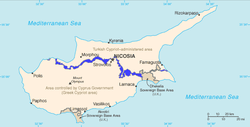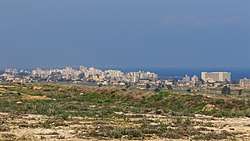Buffer zone


A buffer zone is generally a zonal area that lies between two or more other areas (often, but not necessarily, countries), but depending on the type of buffer zone, the reason for it may be to segregate regions or to conjoin them. Common types of buffer zones are demilitarized zones, border zones and certain restrictive easement zones and green belts. Such zones may be, but not necessarily be, comprised by a sovereign state, forming a buffer state.
Buffer zones have various purposes, political or otherwise. They can be set up to prevent violence, protect the environment, protect residential and commercial zones from industrial accidents or natural disasters, keep prisoners intent on escaping from rapidly acquiring hostages or a hiding place, and have uses in several other scenarios. Buffer zones often result in large uninhabited regions which are themselves noteworthy in many increasingly developed or crowded parts of the world.
Conservation
For use in nature conservation, a buffer zone is often created to enhance the protection of areas under management for their biodiversity importance. The buffer zone of a protected area may be situated around the periphery of the region or may be a connecting zone within it which links two or more protected areas, therefore increasing their dynamics and conservation productivity. A buffer zone can also be one of the protected area categories (e.g. category V or VI of IUCN Protected Area) or a classification scheme (e.g. NATURA 2000) depending on the conservation objective.[1] The term 'buffer zone' initially gained prominence in the conservation of natural and cultural heritage through its usage in the establishment of UNESCO's World Heritage Convention, and the term was intended to be used as follows:
| “ | A buffer zone serves to provide an additional layer of protection to a World Heritage property. The concept of a buffer zone was first included in the Operational Guidelines for the implementation of the World Heritage Convention in 1977. In the most current version of the Operational Guidelines of 2005 the inclusion of a buffer zone into a nomination of a site to the World Heritage List is strongly recommended but not mandatory. | ” |
A buffer zone is intended to avert the effect of negative environmental or human influences, whether or not it embodies great natural or cultural value itself.[3] The importance and function of a buffer zone and the necessary protective measures derived thereof is a relatively new concept in conservation science and can differ greatly for each site.[4]
See also
References
- ↑ A-Z of Areas of Biodiversity Importance: Buffer Zones
- ↑ "International Expert meeting on World Heritage and buffer zones". UNESCO World Heritage Convention. Retrieved 24 Nov 2010.
Background and contents
- ↑ Martin, Oliver, and Piatti, Giovanna (ed.) World Heritage and Buffer Zones, International Expert Meeting on World Heritage and Buffer Zones Davos, Switzerland 11 – 14 March 2008 (Paris: UNESCO, 2009)
- ↑ Ebregt, Arthur and de Greve, Pol, Buffer Zones and their Management: Policy and Best Practices for Terrestrial Ecosystems in Developing Countries (Wageningen: Netherlands Ministry of Foreign Affairs, 2000)
External links
- "The World Heritage Convention and the Buffer Zone". ICOMOS Symposium. Kyushu University Graduate School of Law - Programs in English. November 28–29, 2006. Archived from the original on 2011-06-04. Retrieved 24 Nov 2010.
- "World Heritage and Buffer Zones Patrimoine mondial et zones tampons" (PDF/Adobe Acrobat 3.76 MB). International Expert Meeting on World Heritage and Buffer Zones, Davos, Switzerland 11–14 March 2008. World Heritage Centre. Retrieved 24 Nov 2010.
Buffer zones are an important tool for conservation of properties inscribed on the World Heritage List. All along the history of implementation of the World Heritage Convention, the protection of the “surroundings” of the inscribed properties was considered an essential component of the conservation strategy, for cultural and natural sites alike.
